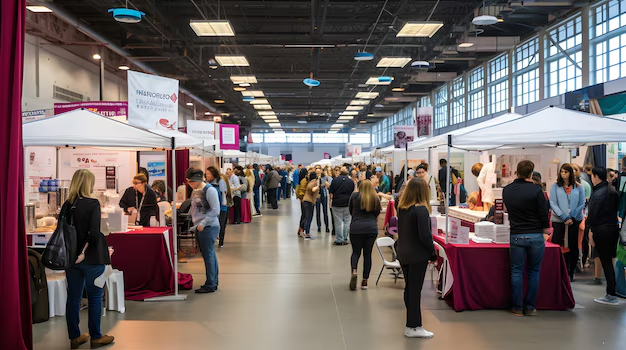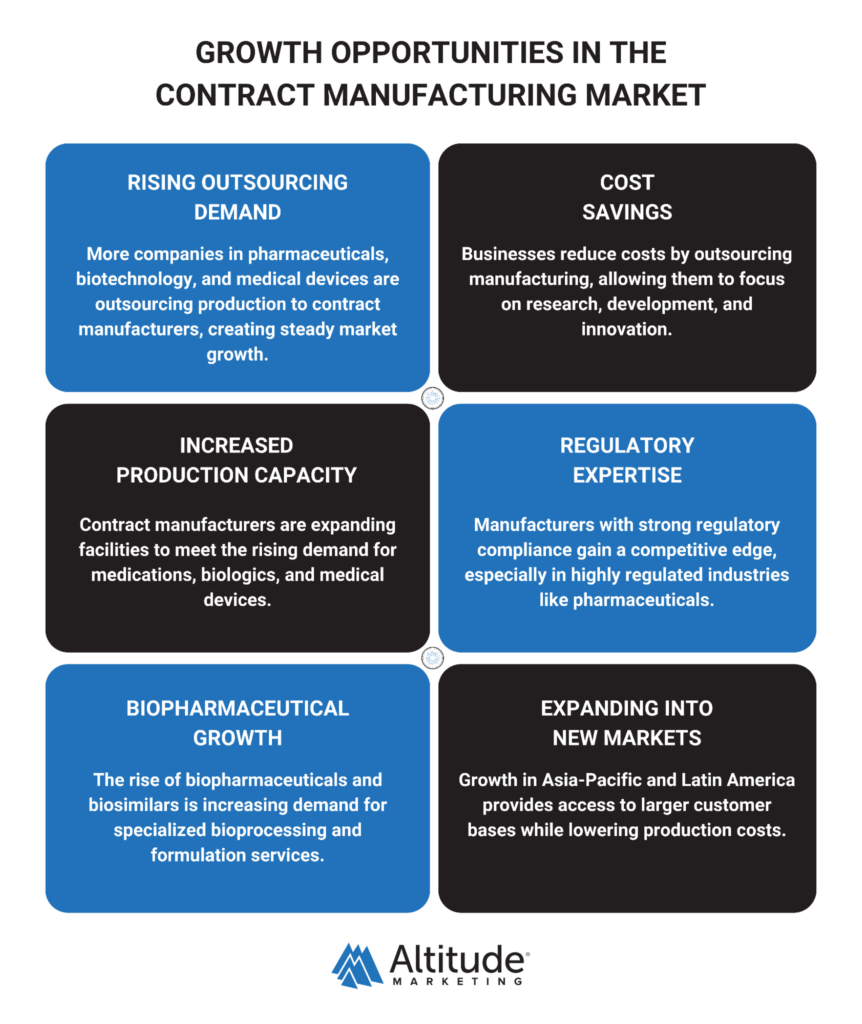Are you looking to improve your trade show booth? To stand out at your next trade show, it’s crucial to adopt the latest industry trends.
Trade shows are one of your most valuable platforms to showcase your capabilities, connect with potential clients, and stay ahead in a fast-moving industry. But with the rise of automation, sustainability, and digital engagement, traditional trade show strategies might not cut it anymore.
As a contract manufacturer, you’re facing increased competition, rising costs, and evolving client expectations. To stand out at trade shows, embrace new technologies and data-driven strategies. Incorporating trends like virtual reality demos and sustainability practices can give your booth a competitive edge and boost your success.
In this blog, we’ll dive into key trade show trends for 2025, share practical tips on how to maximize ROI and explore the top five trade shows you should be attending to stay on top in the contract manufacturing world.

7 Trade Show Trends Every Contract Manufacturer Should Know
Adapting to Market Needs with Flexible Manufacturing
To succeed, contract manufacturers need to keep up with industry changes. Trends like supply chain resilience, new technologies, and sustainability are shaping both manufacturing processes and trade show strategies. Here’s what’s driving the industry forward.
Environmental Sustainability in Manufacturing
As a contract manufacturer, you’re likely already feeling the push toward sustainability. Your customers and clients demand more eco-friendly solutions, and it’s time to adapt. Here’s how manufacturers like you are stepping up:
- Energy-efficient production processes to reduce carbon footprints.
- Sustainable materials in packaging and product development.
- Waste reduction strategies, including recyclable components and lean manufacturing.
This shift is especially critical in industries like pharmaceutical contract manufacturing and personal care contract manufacturing, where sustainability isn’t just a trend—it’s becoming a competitive advantage. If you’re not already prioritizing sustainability, it’s time to rethink your approach!
Building Supply Chain Resilience
The COVID-19 pandemic exposed vulnerabilities in global supply chains, prompting contract manufacturers to rethink their sourcing and logistics strategies. Key developments include:
- Diversification of manufacturing partnerships to reduce dependency on single suppliers.
- Nearshoring and reshoring strategies for greater supply chain stability.
- Enhanced supply chain visibility through digital tracking and predictive analytics.
This trend is particularly crucial in medical device contract manufacturing and the vaccine contract manufacturing market, where supply chain interruptions can directly impact patient care. By building resilience, you’re not just securing your business—you’re protecting the end consumer.
Advanced Technologies Driving Manufacturing Innovation
To stay ahead of the curve, you’re likely investing in cutting-edge technologies that improve efficiency, reduce costs, and boost product quality. Here are a few of the game-changing advancements contract manufacturers like you are integrating into their operations:
- Continuous manufacturing for streamlined production with minimal downtime.
- 3D printing and additive manufacturing for rapid prototyping and small-batch production.
- Artificial Intelligence (AI) and automation to optimize manufacturing workflows and predictive maintenance.
These advancements are transforming industries like the biotechnology contract manufacturing market and the healthcare contract manufacturing market, where precision and efficiency are essential to success. By embracing these technologies, you can enhance your capabilities and better meet the growing demands of these critical sectors.
Adapting to Changing Manufacturing Demands
As market demands evolve, contract manufacturers are offering more flexible production capabilities to accommodate diverse client needs, including:
- Small-scale and niche manufacturing for startups and specialized product lines.
- Personalized medicine production, particularly in the pharmaceutical and healthcare contract manufacturing market.
- On-demand and batch production models for greater agility in response to market fluctuations.
By adopting flexibility and customization, contract manufacturers can better serve industries from plastic manufacturing to high-precision medical devices. These trends are also changing trade show strategies. Companies use events to showcase new ideas, stand out from competitors, and stay relevant in a constantly evolving industry.
7 Key Trade Show Trends for Contract Manufacturers
Trade shows are changing, and as a contract manufacturer, you need to adapt to stay ahead. From AI-powered engagement to sustainable booth designs, these trends are transforming how you attract leads, demonstrate your capabilities, and maximize ROI. Here are seven key trends shaping trade shows in 2025.
1. AI-Powered Trade Show Engagement
AI is transforming how contract manufacturers interact with trade show attendees, making engagement smarter, faster, and more effective. Instead of relying solely on in-person conversations, exhibitors can use AI-driven tools to attract, qualify, and engage leads more efficiently.
- AI Chatbots: These virtual assistants provide instant responses to visitor inquiries, share product details, and even schedule follow-ups—freeing up booth staff to focus on high-value conversations.
- Smart Networking Tools: AI analyzes attendee data to match exhibitors with potential buyers, ensuring contract manufacturers spend time with the most relevant prospects.
- AI-Enhanced Presentations: Interactive screens and AI-driven recommendations adjust content based on visitor interests, delivering personalized product demos and technical insights.
For industries like the plastic contract manufacturing market or medical device contract manufacturing market, AI can help highlight specific solutions tailored to each visitor’s needs.
AI-powered engagement not only improves lead quality but also makes the trade show experience more interactive and efficient. By integrating AI, you as a contract manufacturer can capture more qualified leads and significantly boost your trade show ROI with less manual effort.
2. Hybrid & Virtual Trade Shows Are Here to Stay
Hybrid trade shows are becoming a cost-effective way for contract manufacturers to connect with a broader audience while reducing travel and booth expenses. By combining in-person exhibits with virtual elements, manufacturers can maximize visibility and lead generation.
- Virtual Booths & Live Demos: Exhibitors can showcase their expertise through interactive virtual booths, live-streamed product demonstrations, and on-demand video content, ensuring engagement beyond the physical event.
- Global Accessibility: Attendees who cannot travel can still explore products, attend Q&A sessions, and interact with sales teams in real-time.
- Cost Savings: Hybrid models help exhibitors in the medical device contract manufacturing market and pharmaceutical contract manufacturing market maintain industry presence while cutting down on logistics, travel, and booth setup costs.
Are hybrid trade shows cost-effective for the healthcare contract manufacturing market?
Absolutely, they allow biotechnology and healthcare contract development and manufacturing organization market exhibitors to engage with international partners, generate leads, and showcase innovations, all without the expense of multiple global trade show appearances.
3. Live Demonstrations & Interactive Product Showcases
Live demonstrations are one of the most effective ways for contract manufacturers to capture attention and showcase their expertise. Instead of just telling potential clients about capabilities, exhibitors can show them in real-time, creating a more engaging and memorable experience.
- Augmented Reality (AR) & Virtual Reality (VR): These tools let attendees explore smart factory automation, product development, and assembly processes without needing a physical tour. AR overlays can highlight key product features, while VR simulations provide immersive walkthroughs of complex manufacturing setups.
- Real-Time Prototyping: Medical device contract manufacturing market exhibitors use live machining demonstrations to showcase precision engineering and high-quality manufacturing processes. This hands-on approach builds trust and credibility with potential clients.
- Virtual Cleanroom Walkthroughs: Pharmaceutical contract manufacturing market exhibitors use VR cleanroom simulations to demonstrate compliance with strict regulatory standards. This allows attendees to experience sterile environments, automated drug production, and quality control measures without the constraints of a physical tour.
By integrating live demonstrations and interactive technology, contract manufacturers can engage attendees more effectively, differentiate themselves from competitors, and generate high-quality leads at trade shows.
4. Data-Driven Lead Generation Strategies
As trade show costs rise, contract manufacturers must focus on data-driven strategies to ensure their investment delivers results. Simply collecting business cards is no longer enough—smart tracking tools and AI-powered analytics can help exhibitors capture and convert high-quality leads.
- RFID Badges & Event Apps: These tools track booth visits, attendee engagement, and interaction times, allowing exhibitors to assess lead quality in real-time.
- AI-Driven Attendee Tracking: AI analyzes visitor behavior to identify high-intent prospects, prioritizing follow-ups with attendees who show genuine interest in products or services.
- Post-Show Analytics: Detailed data on booth traffic, engagement rates, and session participation help exhibitors refine their trade show strategy and measure ROI effectively.
For healthcare contract manufacturing market exhibitors, AI-powered lead tracking is particularly valuable. It helps biotechnology and pharmaceutical contract manufacturers identify potential long-term partnerships by analyzing attendee behavior, interactions, and follow-up engagement patterns.
By using data-driven insights, contract manufacturers can streamline their sales process, focus on high-value prospects, and maximize the impact of their trade show presence.
5. Sustainable & Modular Trade Show Booths
Sustainability is becoming a key priority for contract manufacturers, and trade show booth designs are evolving to reflect this shift. Companies are adopting eco-friendly, cost-effective solutions that reduce waste while maintaining a strong industry presence.
- Modular, Reusable Displays: Instead of building one-time-use booths, exhibitors are using modular components that can be reconfigured and reused for multiple events, cutting down on material waste and costs.
- Eco-Friendly Materials: Biodegradable panels, recycled aluminum structures, and energy-efficient LED lighting are replacing traditional booth materials. These sustainable alternatives help exhibitors meet corporate environmental goals while maintaining a professional display.
- Carbon-Neutral Strategies: Some exhibitors, especially in the biotechnology contract manufacturing market, are incorporating low-carbon manufacturing practices into their booth messaging, aligning with industry trends toward green production and energy-efficient processes.
By making sustainable booth designs, contract manufacturers not only reduce costs but also enhance their brand reputation, appeal to environmentally conscious clients, and align with global sustainability trends in manufacturing.
6. Strategic Trade Show Partnerships & Co-Branding
Collaboration is becoming a key marketing strategy for contract manufacturers looking to maximize trade show impact. Co-branding and cross-industry partnerships help exhibitors increase visibility, reduce costs, and attract a broader audience.
- Shared Booths for Greater Exposure: By partnering with complementary businesses, contract manufacturers can showcase integrated solutions, making their booth more attractive to potential buyers.
- Cross-Industry Collaborations: Personal care contract manufacturing market exhibitors are teaming up with packaging and formulation companies to present turnkey solutions for beauty and skincare brands. This approach streamlines the decision-making process for buyers looking for a complete supply chain partner.
- Stronger Brand Positioning: A co-branded booth uses the credibility of both partners, making it easier to attract high-quality leads and establish trust with potential clients.
By forming strategic partnerships, contract manufacturers can stand out in a crowded trade show environment, cut costs, and create more compelling value propositions for attendees.
7. Networking Beyond the Booth: Pre & Post-Event Marketing
Trade show success isn’t just about booth interactions—it starts before the event and continues long after. A strong pre-and post-event marketing strategy ensures that exhibitors connect with the right audience, maximize engagement, and convert leads into long-term clients.
- Pre-Show Outreach: Contract manufacturers use email campaigns and LinkedIn outreach to schedule meetings with potential buyers before the event. This targeted approach increases booth traffic and ensures high-value interactions.
- Live Social Media & Event Hashtags: Posting updates, videos, and insights during the event draws attention to the booth and encourages attendees to stop by. Using event hashtags increases visibility among industry professionals.
- Post-Event Follow-Ups & Retargeting: Personalized emails and follow-up calls help nurture relationships with booth visitors, turning casual conversations into business opportunities.
In the healthcare contract development and manufacturing organization market, exhibitors are using AI-powered retargeting ads and email automation to re-engage trade show leads, ensuring ongoing communication and stronger client conversions.
By integrating pre-show planning, live engagement, and post-event follow-ups, contract manufacturers can maximize trade show ROI and build lasting business relationships.
Top 5 Trade Shows to Attend for Contract Manufacturers in 2025
For contract manufacturers, trade shows are key to staying competitive, networking, and discovering new technologies. Here are the top five must-attend events in 2025.
- The largest automation event in North America focuses on robotics, AI, and smart manufacturing.
- Ideal for contract manufacturers looking to integrate automation, machine vision, and motion control into production.
- Features hands-on demonstrations and networking with automation leaders.
- Covers fabrication, welding, and manufacturing technology, making it a key event for metal and plastic contract manufacturers.
- Includes live equipment demonstrations and insights into emerging fabrication trends.
- Focuses on metal-forming, machining, and industrial automation.
- A great event for manufacturers seeking cost-effective, flexible solutions for production challenges.
- Highlights the latest in packaging, processing, and automation.
- Essential for contract manufacturers in pharmaceutical, personal care, and food production looking for sustainable packaging solutions.
- The largest B2B trade show for advanced manufacturing equipment, software, and industrial technology.
- A must-attend for manufacturers investing in digitization, AI-driven production, and Industry 4.0 solutions.
Each event provides valuable opportunities to connect with industry leaders, discover the latest technology, and gain insights to stay ahead in the contract manufacturing market.
Strategic Approaches to Engagement and Growth
A successful trade show strategy goes beyond just setting up a booth—it requires careful planning, real-time engagement, and strategic follow-ups to maximize ROI.
Pre-Show Planning & Booth Strategy
Pre-show preparation is crucial. Understanding your target audience and tailoring messaging ensures the right prospects visit your booth. Investing in high-visibility booth placement and engaging displays increases foot traffic and brand recall.
On-Site Lead Capture & Engagement Tactics
During the event, efficient lead capture and engagement make a difference. Using QR codes, RFID tracking, and AI-driven networking streamlines connections, while interactive demonstrations keep attendees engaged.
Post-Event Follow-Up & Lead Nurturing
Post-event follow-ups determine long-term success. Personalized email sequences, CRM tracking, and post-show analytics help convert leads into lasting business relationships and measure overall ROI.
A strategic approach to trade shows ensures lasting impact. With the right planning, engagement, and follow-ups, these events become powerful opportunities for growth and industry success.
Growth Opportunities in the Contract Manufacturing Market
The contract manufacturing industry is expanding due to several key factors:

These factors are driving contract manufacturing forward, making it a critical part of global supply chains.
Trade Show Takeaways for 2025 & Beyond
Trade shows are the launchpad for contract manufacturers to showcase expertise, connect with clients, and stay ahead in a competitive market. However, just showing up isn’t enough. With rising competition and evolving expectations, you must fuel your strategy with AI-driven engagement, interactive demonstrations, hybrid formats, and sustainable booth designs to stand out and maximize ROI.
Success comes from careful planning, strong booth engagement, and strategic post-show follow-ups to turn leads into lasting partnerships. A well-executed trade show strategy provides the momentum needed to propel businesses forward and secure long-term industry success.
Related Reads
Contract Manufacturer’s FAQs About Trade Shows
1. What is the average ROI for a trade show?
Trade shows are profitable when executed properly. Businesses expect a 4:1 ROI ratio. This means that the leads and sales generated at the show will be higher than the overall event spending.
Our team of 30 marketing professionals is based in Emmaus, Pennsylvania, just outside New York City and Philadelphia.
2. How do I find vendors for a trade show?
Attending industry-specific networking events is a powerful way to find trade show vendors. These events are hubs for professionals looking to expand their business networks.
3. How much does it cost to set up a booth at a trade show?
For booths smaller than 20′ x 20′, expect to pay around or over $300 per square foot all-in. For booths 20′ x 20′ and larger, you’ll likely pay between $200-300 per square foot all-in or between $100,000 and up.
4. How much do companies spend on trade shows?
For booths smaller than 20′ x 20′, expect to pay around or over $300 per square foot all-in. For booths 20′ x 20′ and larger, you’ll likely pay between $200-300 per square foot all-in or between $100,000 and up.
5. What is the conversion rate for a trade show?
Trade Show Conversion Rate measures the percentage of leads generated at a trade show that convert into customers or take a desired action. It is calculated by dividing the number of leads that convert by the total number of leads generated, then multiplying by 100.
Ready to elevate your B2B marketing?
We help leading business-to-business brands hit their marketing goals. Get in touch to learn how Altitude Marketing can help you reach your peak performance.



